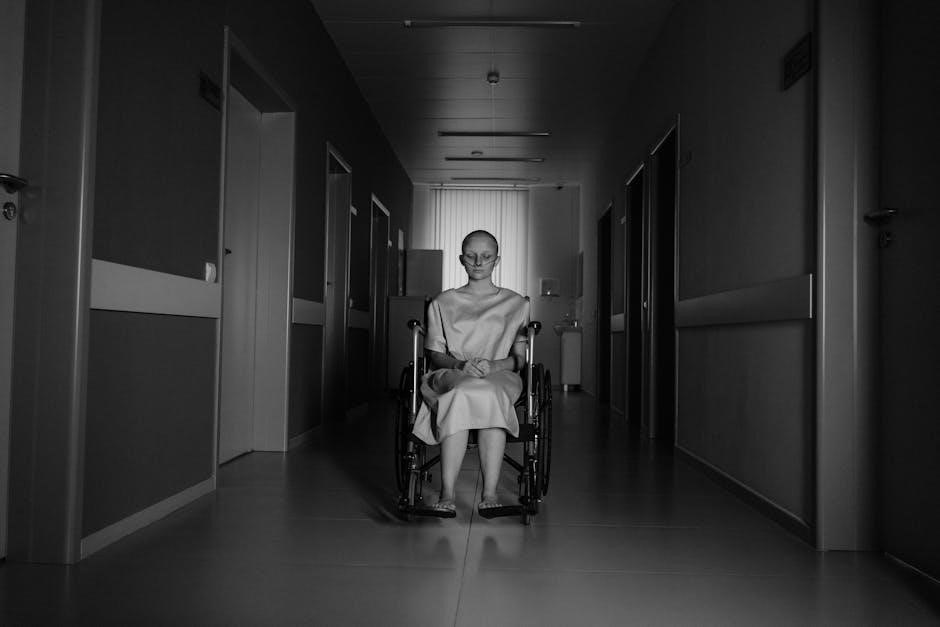Fake cancer diagnosis letters are fraudulent documents designed to deceive individuals or organizations. Often created using templates‚ they falsely confirm cancer diagnoses‚ causing emotional trauma and financial exploitation. These letters undermine trust in medical documentation and have serious legal consequences‚ highlighting the need for vigilance in verifying their authenticity.
What are Fake Cancer Diagnosis Letters?
Fake cancer diagnosis letters are fraudulent documents designed to mimic genuine medical records. They often include false information‚ such as fake doctor signatures‚ fictional treatment plans‚ and fabricated test results. These letters are typically created using downloadable templates and editing software‚ allowing individuals to produce convincing yet deceptive documents. Their purpose is to manipulate others for emotional or financial gain‚ undermining trust in legitimate medical communications.
Why are Fake Cancer Diagnosis Letters Created?
Fake cancer diagnosis letters are created for malicious purposes‚ including financial exploitation‚ emotional manipulation‚ and fraud. Scammers use these documents to deceive individuals‚ organizations‚ or authorities‚ often to gain sympathy‚ money‚ or benefits. They exploit the trust associated with medical records‚ making them a powerful tool for deception and abuse‚ with severe consequences for victims and genuine patients alike.
Components of a Genuine Cancer Diagnosis Letter
A genuine cancer diagnosis letter includes the doctor’s letterhead‚ patient details‚ clear diagnosis‚ treatment recommendations‚ and the physician’s signature. These elements ensure authenticity and credibility.
Standard Elements in a Doctor’s Diagnosis Letter
A genuine doctor’s diagnosis letter includes the clinic’s letterhead‚ patient’s personal details‚ clear statement of diagnosis‚ treatment recommendations‚ and the physician’s signature. It also contains the date of diagnosis‚ treatment start date‚ and specific details about the type and stage of cancer. Contact information and medical license details may be included for verification purposes‚ ensuring the letter’s authenticity and professionalism.
Differences Between Genuine and Fake Letters
Genuine diagnosis letters include clinic letterhead‚ patient details‚ clear diagnosis statements‚ treatment plans‚ and physician signatures. They are professionally formatted and include specific medical information. Fake letters often lack proper formatting‚ contain grammatical errors‚ and may omit crucial details like contact information or licensing numbers. They may also include inconsistent or vague medical information‚ making them appear less authentic compared to legitimate documents.

How Fake Cancer Diagnosis Letters Are Created
Fake cancer diagnosis letters are often created using editing software and templates‚ allowing individuals to alter details and create fraudulent documents that appear legitimate.
Tools and Software Used to Generate Fake Letters
Fake cancer diagnosis letters are typically created using PDF editors like pdfFiller or DocHub‚ and word processors such as Microsoft Word or Google Docs. These tools allow users to edit and customize templates‚ adding fake doctor signatures‚ logos‚ and patient details to create convincing forgeries. The availability of these tools makes it easier for individuals to produce fraudulent medical documents.
Common Sources for Fake Letter Templates
Fake cancer diagnosis letter templates are often sourced from websites offering free downloadable PDFs‚ such as TemplateData.net and Carepatron. These platforms provide editable templates that can be customized with false information. Additionally‚ online marketplaces and forums may distribute such templates‚ making it easy for individuals to create fraudulent medical documents. The widespread availability of these resources contributes to the rise of fake diagnosis letters.
Motivations Behind Creating Fake Cancer Diagnosis Letters
Fake cancer diagnosis letters are often created for financial gain‚ emotional manipulation‚ or to deceive organizations. These fraudulent documents exploit trust in medical professionals for malicious purposes‚ causing significant harm to individuals and systems alike.
Financial Gain and Fraudulent Activities
Fake cancer diagnosis letters are often exploited for financial gain‚ such as fraudulently obtaining donations‚ insurance payouts‚ or sympathy-based crowdfunding. Scammers use these documents to deceive individuals‚ organizations‚ and charities‚ creating false narratives to garner emotional and monetary support. This fraudulent practice not only manipulates trust but also diverts resources away from genuine patients in need‚ causing significant financial and emotional harm to victims and communities alike.
Emotional Manipulation and Deception
Fake cancer diagnosis letters exploit emotional vulnerability to manipulate trust and sympathy. Victims often experience shock‚ fear‚ and anxiety upon receiving such letters‚ believing they or loved ones face a serious diagnosis. This deception can lead to strained relationships‚ mental health issues‚ and irreversible emotional trauma‚ as individuals grapple with the false reality presented by these fraudulent documents.

Legal Implications of Using Fake Cancer Diagnosis Letters
Using fake cancer diagnosis letters involves legal consequences‚ including charges of forgery‚ fraud‚ and criminal impersonation. Offenders face penalties like fines‚ imprisonment‚ and potential civil lawsuits for damages.
Forgery and Fraud Laws
Fake cancer diagnosis letters fall under forgery and fraud laws‚ involving criminal charges for creating and using false medical documents. Offenders face penalties including fines‚ imprisonment‚ and legal action for deceptive practices. These laws target both creators and users of fraudulent letters‚ ensuring accountability for misuse of medical documentation and protection against exploitation.
Consequences of Misusing Medical Documents
Misusing fake cancer diagnosis letters leads to severe legal penalties‚ including fines and imprisonment. Victims suffer emotional trauma‚ financial loss‚ and erosion of trust in medical systems. Institutions face reputational damage‚ while perpetrators risk criminal charges. The misuse of such documents undermines healthcare integrity and can have long-lasting consequences for all parties involved‚ emphasizing the importance of ethical document use and verification processes.

Verifying the Authenticity of Cancer Diagnosis Letters
Verify authenticity through secure digital signatures and direct contact with medical institutions. Ensure letters include specific patient details‚ doctor credentials‚ and official letterhead to confirm legitimacy and prevent fraud.
Methods to Check for Genuine Documentation
To verify authenticity‚ check for secure digital signatures‚ official letterhead‚ and contact details of the medical institution. Ensure the letter includes specific patient information‚ diagnosis details‚ and treatment plans. Cross-reference with the doctor or hospital directly. Look for consistent formatting and absence of errors. Verify the legitimacy of the doctor’s credentials and ensure the document aligns with standard medical protocols.
Role of Medical Institutions in Verification
Medical institutions play a crucial role in verifying cancer diagnosis letters by maintaining detailed patient records and providing official documentation. They ensure letters include authentic signatures‚ letterhead‚ and specific medical details. Hospitals can confirm the legitimacy of a diagnosis through direct communication‚ reducing the risk of fraud. Their involvement is essential to uphold the integrity of medical documentation and protect against fraudulent activities.
Psychological Impact on Victims of Fake Diagnosis
Fake cancer diagnoses cause severe emotional trauma‚ leading to anxiety‚ depression‚ and trust issues. Victims often experience long-term psychological distress and feelings of betrayal.
Emotional Trauma and Trust Issues
Victims of fake cancer diagnoses often experience severe emotional trauma‚ including anxiety and depression. The revelation of the fraud can lead to profound trust issues‚ damaging relationships with medical professionals and loved ones. The emotional toll is compounded by feelings of betrayal‚ leaving long-lasting psychological scars and a diminished faith in medical documentation and authority figures.
Long-term Effects on Mental Health
Fake cancer diagnosis letters can lead to lasting psychological damage‚ including PTSD‚ anxiety‚ and depression. Victims often struggle with heightened stress and hypervigilance‚ fearing future deception. The betrayal of trust in medical professionals can persist for years‚ affecting daily life and relationships. These experiences may also trigger existential fears‚ profoundly impacting mental well-being and overall quality of life.

Preventive Measures Against Fake Diagnosis Letters
Implementing secure digital signatures‚ rigorous verification processes‚ and public awareness campaigns can help combat fake cancer diagnosis letters‚ ensuring authenticity and protecting individuals from emotional and financial harm.
Secure Digital Signatures and Verification Processes
Implementing secure digital signatures ensures the authenticity of cancer diagnosis letters‚ preventing forgery. Verification processes‚ including encryption and multi-factor authentication‚ safeguard documents from tampering. Timestamps and traceable digital trails enhance security‚ maintaining the integrity of medical records and preventing fraudulent use of fake cancer diagnosis letters.
Public Awareness Campaigns
Public awareness campaigns play a crucial role in educating individuals about the risks of fake cancer diagnosis letters. By promoting verification methods and highlighting the consequences of fraudulent documents‚ these campaigns empower people to recognize and report suspicious letters. They also encourage collaboration between authorities and the public‚ fostering a collective effort to combat fraudulent activities and protect vulnerable individuals from emotional and financial harm.
Case Studies and Real-Life Examples
Notable cases reveal individuals using fake cancer diagnosis letters for financial gain‚ emotional manipulation‚ and deceit‚ leading to severe legal consequences and public distrust in medical documentation.
Notable Cases of Fake Cancer Diagnosis Scams
Michelle Bodzsar and Ben Miller fabricated a fake cancer diagnosis for their son‚ raising over $60‚000 and shaving his head to deceive supporters. Another case involved a tutor posing as a psychologist‚ faking a cancer diagnosis to exploit NDIS funds. These scams highlight the devastating impact of fraudulent medical documents‚ leading to financial loss‚ emotional trauma‚ and erosion of trust in genuine medical communications.
Lessons Learned from Past Incidents
Past incidents reveal the importance of verifying medical documents through official channels. Ensuring letters include authentic details like doctor signatures‚ clinic letterheads‚ and specific medical information can prevent fraud. Public awareness campaigns and stricter penalties for forgers are essential to combat fake cancer diagnosis letters‚ protecting both individuals and organizations from emotional and financial harm.
The rise of fake cancer diagnosis letters underscores the need for vigilance in medical documentation. Ensuring authenticity through secure digital signatures and verification processes is crucial to prevent fraud and protect individuals from emotional and financial harm‚ fostering trust in healthcare systems.
Importance of Vigilance in Medical Documentation
Vigilance in medical documentation is critical to combat fake cancer diagnosis letters. Ensuring authenticity prevents emotional trauma‚ financial fraud‚ and legal repercussions. Secure digital signatures‚ verification processes‚ and cross-checking with medical institutions are essential to validate documents. Trust in healthcare systems depends on the integrity of medical records‚ making vigilance a cornerstone in safeguarding patients and maintaining ethical standards in healthcare communication.
Future of Secure Diagnosis Letters
The future of secure diagnosis letters lies in advanced technologies like blockchain and AI for authentication. Digital signatures‚ biometric verification‚ and encrypted platforms will ensure integrity; Standardized templates and real-time verification systems will combat fraud. Public awareness campaigns will educate individuals on spotting fake documents‚ fostering a culture of vigilance. These measures will safeguard medical communication and restore trust in diagnosis letters.